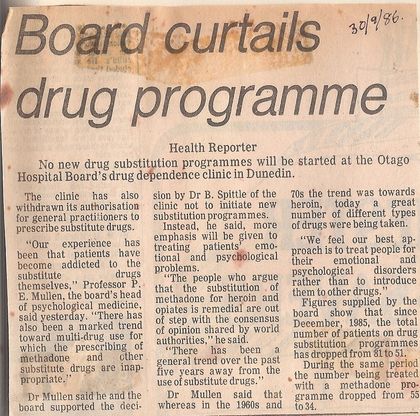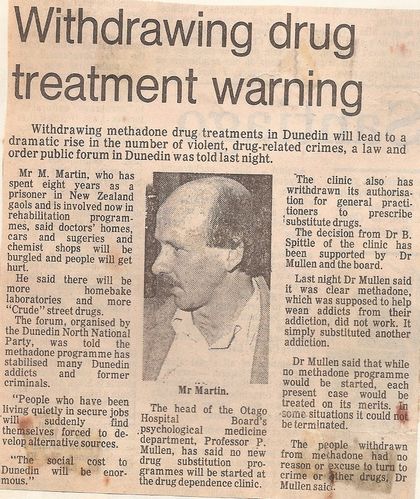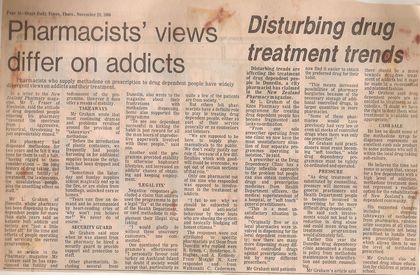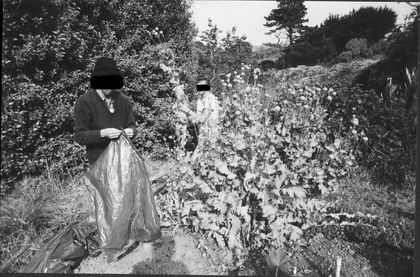This article is about what can happen if a drug substitution programme is suddenly cancelled.
In 1978, the Dunedin Hospital Board followed a New Zealand-wide trend and began an opiate substitution programme for local addicts using the synthetic narcotic, methadone. The main aims were to try to stabilise the lives of the addicts and to stop them from committing crimes to obtain drugs as well as to limit the spread of diseases from sharing needles. Prior to this, a few local doctors had been prescribing on an ad hoc basis for the small number of addicts in Dunedin, but there had been no overall strategy or control.
A pharmacy in the city centre was designated as the pick-up point and daily doses of oral non-injectable methadone were dispensed to around a dozen individuals. As part of the programme all of the methadone users attended regular counseling with staff at the Department of Psychological Medicine and the emphasis was on controlled withdrawal.
Dosages were also capped at a maximum of 50 milligrams per day and this was gradually reduced until the addict became drug-free. If people couldn’t cope with this regime there was some discretionary leeway to allow them to withdraw more slowly or begin the programme again. Long term maintenance (which is now the norm) was definitely not supposed to be available.
By 1986, the number of people on methadone had risen to somewhere in the region of 120. What caused this big jump in the number of opiate addicts in Dunedin to occur so quickly?
There were two main reasons.
Firstly, there was an increase in the supply of illegal drugs. Although the collapse of the Mr Asia drug ring had reduced the amount of overseas heroin on the streets of New Zealand, home-bake heroin – made in clandestine local laboratories from prescription pain-killers – had become widely available. Many people had also started stealing opium poppies in the summer months and when the resin from these was combined with acetyl anhydride (stolen from chemists) it was easy to produce a rough and ready dose of morphine/heroin at no financial cost. In the early eighties many addicts started growing their own supplies of poppies.
Secondly, sometime in late 1984 or early 1985 the methadone clinic got a new director, Dr James Hannah, a well-respected physician who was the head doctor at Cherry Farm Mental Hospital. For most of the week the programme was based at the hospital (which was a 30 minute drive from the city) and the people on methadone were only seen one day at week in the city itself, first at the Psych Service building at the Psychology Department and later at Wakari Hospital.
While the previous regime had stuck closely to overseas models – with a regime of urine testing prior to prescribing to make sure the potential client was really truly addicted and not just dissembling in order to get free drugs – Dr Hannah dispensed with these tests and it was possible to get onto the programme at a high dose on the first appointment.
It was easy to get on the programme now and it was also easier to stay on too, as Dr Hannah was more flexible about allowing people to withdraw much more slowly. As a result many casual users, who in different circumstances might not have become addicts, got onto the programme with little more than a good story and a few fresh needle marks on their arms.
There was good money to be made in selling their weekend takeaway doses (when the pharmacy was closed) and some young people were coached into signing up by older established methadone users who wanted access to their supplies. For almost two years it was so easy to get methadone in Dunedin that some people moved to Dunedin from other parts of the country (particularly Christchurch) to take advantage of the looser controls. This new generation of fresh addicts often saw methadone as a useful currency that they could sell and/or swap for other drugs at weekends. When Dr Hannah retired in 1986, methadone had become the most widely available and cheapest (at $1 per mg) narcotic in Dunedin.
This big increase in the population of local drug addicts did not go unnoticed by the local media or the Hospital Board, which decided that it was time to take action.
In September of 1986 Professor Paul Mullen, the head of the Hospital Board’s Department of Psychological Medicine, which administered the clinic, appointed a new director, Dr Bruce Spittle. His clear mandate was to reduce the number of people on methadone.
Spittle’s first move was to announce that no new drug-substitution programmes would be started. His second was to force all of the clients onto rapid-reduction programmes, often one milligram a day as opposed to one milligram a week or every two weeks. This may not sound like much but anyone addicted to methadone can tell you how painful a rapid reduction can be. Once people’s doses had been reduced to nothing, that was it and there was no more practical help from the clinic.
“Dr Spittle told me I was obviously an incurable drug addict and he gave me a final prescription which reduced my dose to zero at the end of the month. Did I stop using drugs? Absolutely not but I had to do so illegally again.” (Anonymous Dunedin drug user)
In an article in the Otago Daily Times, Dr. K.W. Berenson, the Chief Superintendent of the Hospital Board denied that people were being forced off methadone against their will.
“No patients at present on the methadone treatment will be taken off unless the person concerned asks for the treatment to be discontinued.” (ODT 25/9/86)
In the following day's paper Professor Mullen also asserted that patients who were having their methadone treatment reduced were “receiving smaller doses by mutual agreement.” (ODT 26/9/86) He went on to say that if some people were “finding their reduction too difficult to cope with then consideration would be given to actively stabilising their doses.”
Both these statements were hotly contested by the affected individuals and some of them organized a support and advocacy group called Forum X.
The group's spokesperson, Mike Martin, although not a drug user himself predicted that the “stabilising effect” provided by methadone was infinitely preferable to the obvious alternatives which were “more home-bake laboratories and more crude street drugs.” He predicted that the “social cost (of forcing people off programme) would be enormous.” (‘Withdrawing Drug Treatment Warning’ ODT 28/8/86)
Just four days after Professor Mullen had said that no-one was being forced off the programme, he did an abrupt about-face and announced that it was now being axed completely. It’s hard to believe he made this decision in just four days!
In an article entitled ‘Board curtails Drug Programme’ (ODT 30/9/86) he admitted that people were being removed from the programme whether they liked it or not. At the same time the clinic also withdrew its authorisation for any other general practitioners to prescribe methadone to patients (ODT 30/9/86).
“It is clear that methadone, which was supposed to wean addicts off their addiction, did not work. It simply substituted one addiction for another.” (ODT 30/9/86)
He also said that anyone withdrawing from methadone “had no excuse to turn to crime or any other drugs.”
Over the next few months practically all of the people on the programme had their doses rapidly reduced to zero and by late 1986 there was no longer a methadone programme in Dunedin.
Some of those affected left the city and moved to other areas whose hospital boards still had a functioning programme. But many others had no choice but to remain in the city. They were still addicts. What could they do? According to Bruce Spittle they could simply stop taking drugs. He didn’t take them and they didn’t need to either. Most of the affected people resorted to two main solutions. They began stealing drugs from pharmacies/doctors/vets etc, as well as poppies in summer and/or found a sympathetic general practitioner who would prescribe some kind of daily opiate regime for them.
By the mid-eighties all pharmacies had modern electronic alarm systems and it was much more difficult to break into them than it had been the previous decade. Despite this, people started trying. The main method was to use a quick smash-and-grab approach to get bottles of opium tincture or packets of codeine to convert into heroin.
Several sympathetic local doctors had been shocked by the closure of the programme and began to prescribe alternative narcotics to former methadone users. These included codeine, palfium and pethidine, but by far the most common drug prescribed was opium tincture, or paregoric as it is sometimes called. It is a mixture of opium, alcohol and camphor which used to be the basis of cough medicines like Gees linctus.
It was easy for the addicts to burn off the alcohol, freeze out the camphor and turn the opium into an injectable heroin by adding acetyl anhydride. Paregoric quickly became the new drug of choice in Dunedin and was readily available for 50 cents a milligram on the street. More and more doctors were persuaded (or bullied) into prescribing the drug.
Two pharmacists actually started selling it out the back door to certain customers. One was caught and struck off the Pharmaceutical Register. A number of doctors were also censured in 1987/88 for prescribing or over-prescribing paregoric and other drugs to former methadone patients and their ability to prescribe opiates was curtailed.
“I came back to Dunedin from overseas with a heroin habit and found out they’d cancelled the methadone programme. My doctor started writing paregoric for me and I started buying it from other users as well. Soon I was cooking up and shooting it two or three times a day.” (Anonymous Dunedin drug user)
Several months after the last few people had been forced off the programme Dunedin’s Midweeker newspaper reported (19/4/87) that there had already been 20 pharmacy burglaries so far that year compared with four at the corresponding time in the previous year. Three months later, a story in the Otago Daily Times headed 'Increase in Pharmacy Burglaries' (15/7/87) reported that the number of pharmacy burglaries was now up to 26, plus 21 break-ins to doctors' surgeries and vet clinics – and six to doctors' houses.
In the article Dr Berensen denied that this increase had anything to do with shutting down the methadone programme and put it down to “an increase in such burglaries throughout the country”, although he provided no evidence to support this contention.
As well as the increase in burglaries at least three people died and a number of others were hospitalised in 1987 after injecting sodium pentobarbitone stolen from veterinary clinics. Another person died from an overdose of paregoric.
In April of 1987, 31 year-old Steven Duncan died when one of his heart valves became infected. He had been on a methadone programme in Australia and tried several times to seek help at the clinic in Dunedin but had been refused. He was already in poor health from years of abuse and he had predicted to many people that he would die if he was forced back to using impure street drugs such as paregoric. (ODT 16/4/86)
In May, frustrated and depressed by the death of his good friend Duncan, Project X founder Mike Martin committed suicide.
On December 29, 32 year-old Beverly Edwards, one f those forced off the programme, died of an overdose. The corner’s report stated that the cause of death was “the effects of asphyxia complicating a convulsive episode occurring during the partial withdrawal from the drug, dextromoranmide (palfium).” She had been given a short prescription of this drug by a local doctor when she could not get any methadone. Her son still holds Dr Spittle partly responsible for her death.
The Hospital Board’s heavy-handed approach was beginning to draw criticism from concerned health professionals. As far back as September 1986, several staff had voiced their concerns about the new policies during a meeting of Drug Treatment Centre personnel and the Health Department’s Drug Advisory Committee. The Medical Superintendent of Auckland’s Carrington Hospital, Dr. F McDonald, also expressed “grave reservations” about the Board’s approach.
How many of these pharmacy burglaries and deaths can be laid at the door of the Hospital Board is of course impossible to say but the board must surely take some responsibility for what occurred when people who had been given a legal recourse to cope with their drug addictions were suddenly forced back into the criminal world.
In an article in the New Zealand Pharmacy Journal by Mr Lex Graham (cited in the ODT in an article called ‘Disturbing Drug Treatment Trends’ (20/11/86) the owner of Knox Pharmacy, who had been dispensing methadone since the programme started in 1978, gave his cautious backing to drug substitution programmes, saying that in his opinion both the addicts and society are on balance “just a little better off.” He acknowledged that methadone provided many people with much-needed stability and made a subtle criticism of the Board’s policy by noting that “A prescriber (Dr Spittle) at the Drug Dependency Clinic has a fairly inflexible approach to the problem.”
He also said that pharmacies were becoming increasingly attractive to burglars because of the “storage of additional controlled drugs” (i.e. paregoric) now that many former methadone patients were now being "maintained" on this drug by local doctors.
A number of Dunedin doctors, not just those who were prescribing to former addicts, did not approve of the way the Hospital Board was handling the issue but were reluctant to publicly criticise the board in case the criticism came back to hurt them. Dr John Dobson from Christchurch was freer to speak his mind and in an article entitled ‘Methadone Treatment Policy Criticised” he said that he thought some aspects of the Dunedin Drug Clinic were “inhumane.” (ODT 25/9/86)
A private survey of 25 ex-patients found that 100% had continued to take narcotics since being forced off and that 100% of them would prefer to go back on methadone (or some other narcotic) and not be forced to withdraw unless they asked to. These survey forms and some other private submissions were presented to the Chairman of the Hospital Board, Mike Cooper by Mike Martin shortly before his death.
Even nationwide media had woken up to the fact that something strange was happening in Dunedin. In May of 1988 More magazine published a feature article about the death of Beverly Edwards and the situation with the clinic in Dunedin.
Soon afterwards, Hospital Board chairman Mike Cooper called for an inquiry and organised interviews with doctors, social workers, nurses, the police, probation officers and drug users themselves. After these interviews an all-day session was organised at the hospital with experts flown in from all over the country. Eventually, later that year, Dr Spittle tendered his resignation and went overseas on leave.
Dr Gill Carradoc-Davies, a clinical psychiatrist for the Hospital Board, was offered the position of clinic director and accepted. Before taking it up she went on a two-month study tour of drug rehabilitation clinics in the United States and England. In December 1988, the Dunedin Drug Clinic once again began prescribing methadone for local addicts.
Nowadays, Dunedin drug addicts, like most around the country, are offered a choice between methadone and suboxone (another synthetic narcotic) and can stay on a drug substitution programme as long as they need to without being pressured to come off drugs before they are ready to. One seldom hears of a pharmacy being burgled, no one is prescribing or selling paregoric and hopefully one day soon both AIDS and Hepatitis C will both be just be a bad memory.



